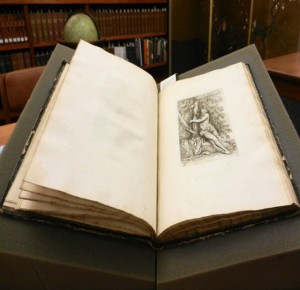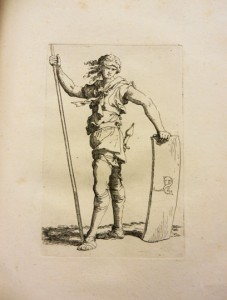
In addition to the over 7,000 linear feet of archival collections made available for study at the University of Houston Special Collections, we are also proud to offer over 100,000 rare and antique books for use in our reading room. Each month we will highlight a text from our collections and what makes it so special.
This spring semester we have been fortunate to host our first-ever UH Special Collections Social Media Intern, Shelby Love. As part of her duties, Love has been curating our Book of the Month series here on the blog. For this month (and many to come, no doubt) we share a Book of the Month selection from Shelby Love.

Salvator Rosa has ludentis oty Carolo Rubeo singularis amicitiæ pignus D.D.D. open to display female figurine
Book of the Month: Salvator Rosa has ludentis oty Carolo Rubeo singularis amicitiæ pignus D.D.D.
Why so Special? Salvator Rosa has ludentis oty Carolo Rubeo singularis amicitiæ pignus D.D.D. is a series of etchings by Salvator Rosa, an Italian painter and printmaker. The book was dedicated to Rosa’s Roman patron Carlo de’ Rossi. The book contains beautifully detailed portraits of peasants, women, and groups of soldiers as well as some mythological scenes. Rosa is considered to be one of the most original artists and bizarre characters of the 17th century.
The collection in this book features many etchings from Rosa’s figurine series, which went on to influence many Italian artists as elegant “stock” figures to incorporate into their works. Without the ability of color, Rosa’s traditional prints illustrate the versatility of the line to distinguish subject from object, light from shadow, and detail from outline.
This item presents a rare opportunity to experience the intricate and original artwork without the unfortunate distortion and separation of museum glass. The texture of the plate is softly written into the fabric of the paper and the viewer can also see the indention made into the paper from the plate’s edges after being run through the engraving press. These details bring the viewer excitingly close to the printmaking process that was used to create these images in a way that only originals can. Aesthetically engaging and enlightening, this collection by Rosa is just one captivating gem in Special Collections.
Location: Those interested in viewing this series of etchings in person may request call number ND623.R7R7x in the Special Collections Reading Room.
